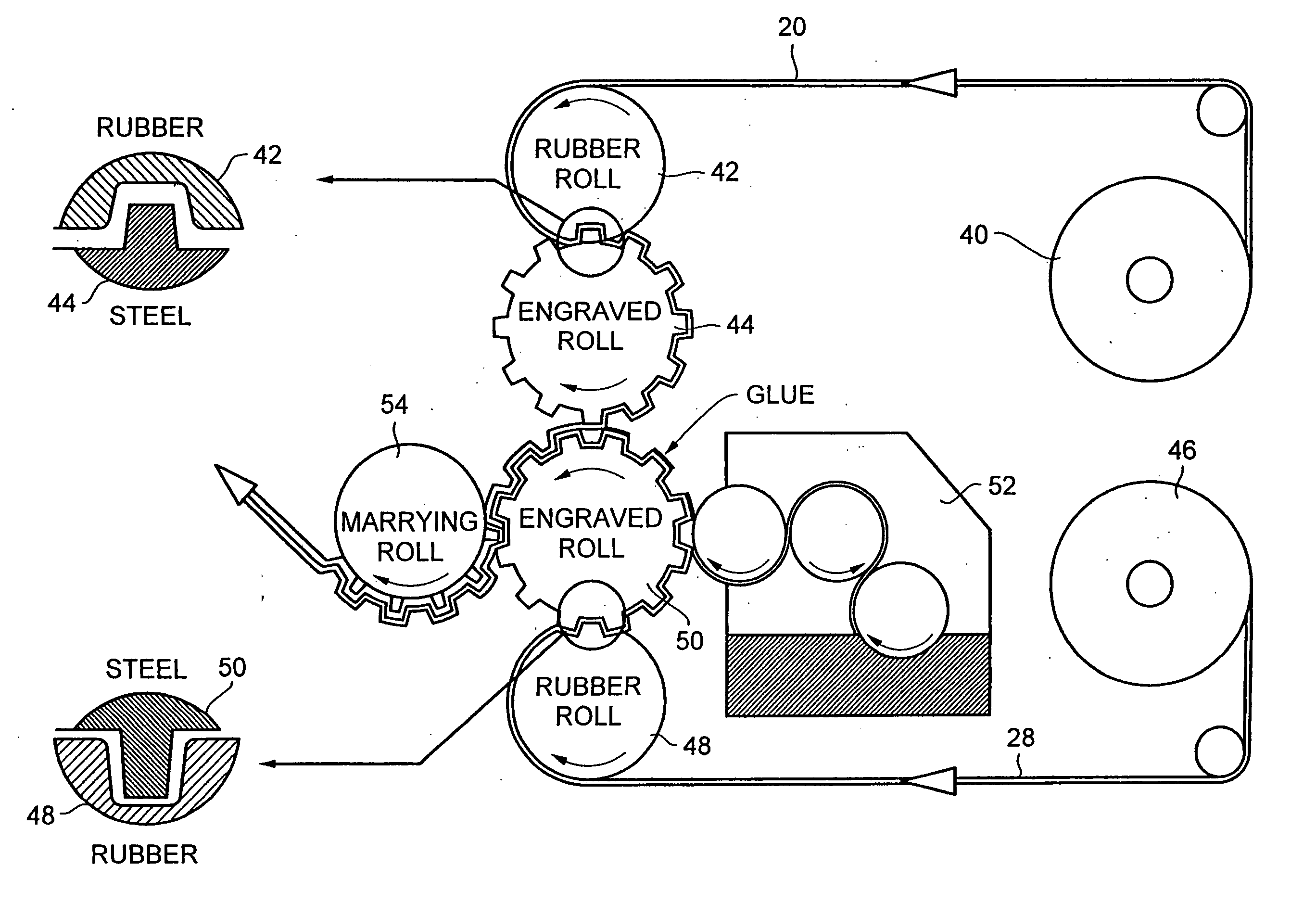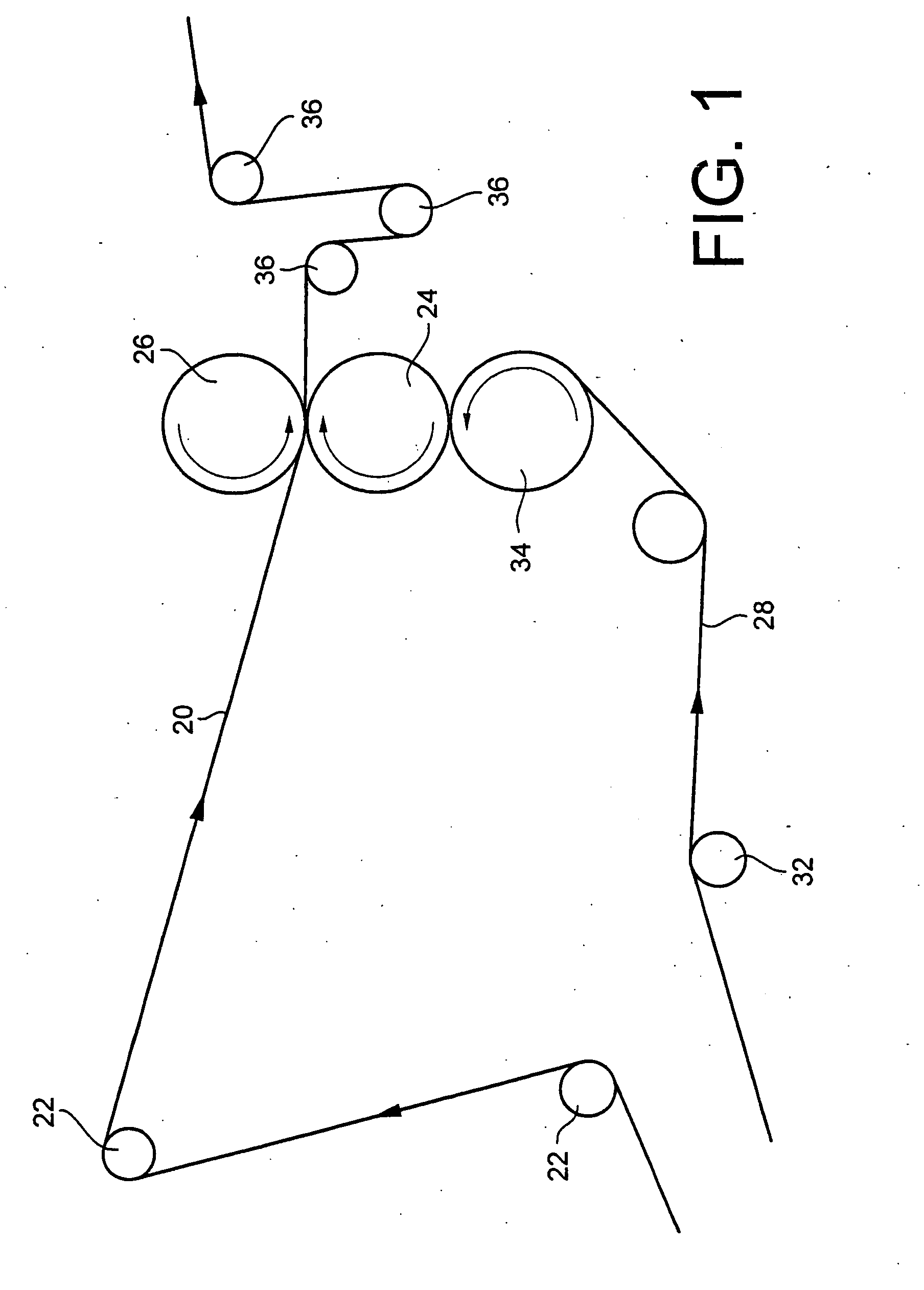Multi-ply absorbent paper product having impressed pattern
a technology of absorbent paper and absorbent paper, which is applied in the field of absorbent paper products, can solve the problems of tissue paper adversely affecting one or more of the other parameters, reducing the strength of tissue products, and affecting the perceived puffiness and softness of tissue products
- Summary
- Abstract
- Description
- Claims
- Application Information
AI Technical Summary
Benefits of technology
Problems solved by technology
Method used
Image
Examples
example 1
[0100] This example provides a comparison between tissue product converted using the conventional emboss process and that converted using the differential depth embossing process. Tissue base sheets were made on a crescent former pilot paper machine using 15 degree bevel at a percent crepe of 22%. The base sheet furnish contains 65% Southern hardwood kraft and 35% Northern softwood kraft. Base sheets were converted to two-ply tissue using the conventional steel-to-rubber process and the differential depth emboss process. The rubber rolls with hardness 40 Shore Durometer A were used in both processes. Both processes used the same emboss pattern shown in FIG. 7. Each process converted base sheets at three or four penetration depths (or nip pressures). Physical properties of various tissue products were measured and compared. FIGS. 9-13 show the test results. It can be seen from FIG. 9 that the differential depth emboss process made product with slightly lower caliper at equal GM tensi...
example 2
[0101] This example compares and illustrates the differences between the differential depth emboss product and the conventional tissue product. Tissue base sheets were made from a furnish containing 60% Southern hardwood kraft, 30% Northern softwood kraft and 10% Broke. Base sheets were made with square blade at 20% crepe ratio and converted into two-ply tissue using the conventional process and the differential depth emboss process. The hardness of rubber rolls used in both processes is 40 Shore Durometer A. Both processes used the same emboss pattern corresponding to the emboss pattern shown in FIG. 8. Each process converted base sheets at two penetration depths (or nip pressures). The basis weight of two-ply tissue product is 17 to 20 lbs / 3000 square ft. Physical test results are plotted in FIGS. 14-16. FIGS. 14 and 15 indicate that two-ply tissue converted using the differential depth emboss process has higher caliper and lower friction at equal GM tensile strength than that con...
example 3
[0102] This example illustrates the effect of the emboss process on two-ply tissue. The furnish of tissue base sheets contains 30% Northern softwood kraft, 60% Southern hardwood kraft and 10% trial broke. Base sheets were made at basis weight of 9.3 lbs / 3000 square ft using a square crepe blade at 72 degrees creping angle. The conventional process and the differential depth emboss process were used to converted base sheet to two-ply tissue. The rubber rolls with hardness 40 Shore Durometer A were used in both processes. The same emboss pattern used in Example 2 above was used in this example. Two-ply tissue was converted using the conventional emboss process at penetration depth 0.085 inches. For two-ply tissue converted using the differential depth emboss process, the penetration depth is 0.095 inches for top ply (or outside) and then the top and bottom (or inside) plies are embossed together at penetration depth 0.065 inches.
[0103] Table 1 below lists all of the physical properti...
PUM
| Property | Measurement | Unit |
|---|---|---|
| aspect ratio | aaaaa | aaaaa |
| aspect ratio | aaaaa | aaaaa |
| aspect ratio | aaaaa | aaaaa |
Abstract
Description
Claims
Application Information
 Login to View More
Login to View More - R&D
- Intellectual Property
- Life Sciences
- Materials
- Tech Scout
- Unparalleled Data Quality
- Higher Quality Content
- 60% Fewer Hallucinations
Browse by: Latest US Patents, China's latest patents, Technical Efficacy Thesaurus, Application Domain, Technology Topic, Popular Technical Reports.
© 2025 PatSnap. All rights reserved.Legal|Privacy policy|Modern Slavery Act Transparency Statement|Sitemap|About US| Contact US: help@patsnap.com



